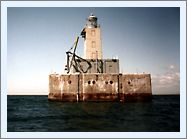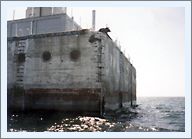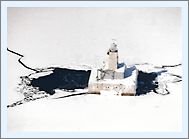|
Historical
Information

Lansing Shoals are located approximately 4 ˝ miles northeast of
Squaw Island, at the northern end of a narrow passage through which
vessels are forced to navigate on their trip between the Straits and the
northern harbors of Lake Michigan and Green Bay. Consisting of a number
of detached rocky strewn reefs with depths of less than 17 feet, the
reef long represented a significant threat to any vessel master
unfamiliar with the intricacies of the passage.
As traffic through the Straits burgeoned in the late 1890’s with
increasing ore shipments from Escanaba, mariners began lobbying the
Lighthouse Board to improve the lighting of the shoals. While the
construction of manned light stations in such locations was preferred,
the high costs associated with offshore construction made the anchoring
of lightships over such obstructions a significantly more expeditious
and cost effective solution. Without funding for a new vessel, the Board
was forced to review its existing inventory to identify if arrangements
could be made to allow the relocation of an existing vessel to mark
Lansing Shoals.
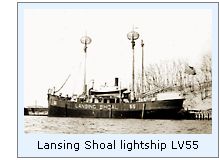 Lightship LV55 had been serving at Simmons Reef since October 24,
1891, and with a shift of traffic patterns to the south of White Shoal,
Simmons Reef had become less of a threat to mariners. Thus, the decision
was made to replace the LV55 with an acetylene gas buoy in 1899, thereby
freeing-up the lightship to be reassigned to duty on Lansing Shoal.
However, since the Simmons Reef lightship had been established by an Act
of Congress, the Board needed yet another Act to allow relocation of the
vessel, and thus the Board requested permission to make the change in
its annual report for 1899. A joint resolution of Congress approving the
relocation was made on May 3, 1900, and with the establishment of the
Simmons Reef Gas Buoy on July 19, 1900, LV55 was moved and anchored on
Lansing Shoals. Lightship LV55 had been serving at Simmons Reef since October 24,
1891, and with a shift of traffic patterns to the south of White Shoal,
Simmons Reef had become less of a threat to mariners. Thus, the decision
was made to replace the LV55 with an acetylene gas buoy in 1899, thereby
freeing-up the lightship to be reassigned to duty on Lansing Shoal.
However, since the Simmons Reef lightship had been established by an Act
of Congress, the Board needed yet another Act to allow relocation of the
vessel, and thus the Board requested permission to make the change in
its annual report for 1899. A joint resolution of Congress approving the
relocation was made on May 3, 1900, and with the establishment of the
Simmons Reef Gas Buoy on July 19, 1900, LV55 was moved and anchored on
Lansing Shoals.
LV55 was one of three identical light vessels authorized in a $60,000
appropriation on March 2, 1899. Built at the Blythe Craig Shipbuilding
Co at Toledo, Ohio, the three 103-foot oak-planked vessels were equipped
with a single screw driven by a small single cylinder steam engine.
These engines were designed to provide the vessels with sufficient power
to allow them to get on and off station under their own power. Thereby
eliminating the costs associated with having a lighthouse tender moving
them on and off station at the beginning and end of the navigation
season. Work on the vessels was completed on September 15, 1891, and on
delivery at the Detroit lighthouse depot they were officially designated
with hull numbers LV55, LV56 and LV57. The three vessels departed the
Lighthouse Depot under their own steam on October 19, and reaching Port
Huron that same evening, were met by the lighthouse tender DAHLIA, which
towed them north through Lake Huron and placed all three vessels on
their stations on October 24th, 1891.
Determined to affect a more permanent solution, the Board requested
an appropriation of $250,000 to construct a permanent light station on
Lansing Shoals in its annual report for 1908. However, with a tight
economy and numerous other projects underway, Congress repetitively
turned a deaf ear to the request. Thus, the venerable LV55 continued her
dedicated service over Lansing Shoals for the following twelve years,
until at her winter lay-up in Cheboygan in 1920 her hull was found to be
rotting beyond repair and she was declared "unseaworthy," and
removed from service. Thus, in 1920, the search was on for a replacement
vessel to serve at Lansing Shoal.
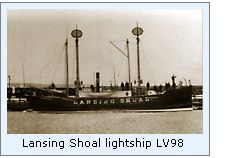 LV98 was built at the Racine-Truscott-Shell Lake Boat Company in
Muskegon in 1914. Built of steel in the "Whaleback style", her
overall length was 101', and she drew an impressive 23' 6".
Initially assigned to duty off Buffalo Harbor on June 12, 1915, she
served at that anchorage until she was transferred for relief service in
Lake Michigan in 1918. Deciding that assignment to Lansing Shoal was of
greater importance than continued service as a relief vessel, LV98 was
permanently reassigned to Lansing Shoal, taking up her new anchorage on
September 29, 1920. LV98 was built at the Racine-Truscott-Shell Lake Boat Company in
Muskegon in 1914. Built of steel in the "Whaleback style", her
overall length was 101', and she drew an impressive 23' 6".
Initially assigned to duty off Buffalo Harbor on June 12, 1915, she
served at that anchorage until she was transferred for relief service in
Lake Michigan in 1918. Deciding that assignment to Lansing Shoal was of
greater importance than continued service as a relief vessel, LV98 was
permanently reassigned to Lansing Shoal, taking up her new anchorage on
September 29, 1920.
Since the construction of the first 350-foot long lock at the Soo in
1855, the size of the locks had served as the limiting factor for the
length of commercial vessels able to move through them in and out of
Lake Superior. Since larger vessels allowed larger loads, while still
allowing for the same number of trips during the navigation season, ship
owners were constantly clamoring for the construction of larger locks at
the Soo, and a thirty year cycle of lock replacement began. With the
opening of the twin 850-foot long Davis and Sabin locks in 1919, vessels
quickly grew to previously unimagined dimensions, and the Army Corps of
Engineers was pressed to ensure that all navigation channels throughout
the lakes were improved to handle longer and deeper draft vessels.
The increased size and weight of these larger vessels allowed them to
break through thicker ice, and thus they were able to extend both ends
of the navigation season. However, largely as a result of her diminutive
size, LV98 was forced to wait for almost complete ice-out in the spring
before making her way out of winter quarters, and was likewise forced to
leave her station before the close of the navigation season in order to
avoid becoming trapped in the thickening ice. Thus, many vessels found
themselves navigating the area around Lansing Shoals without the benefit
of a light to guide the way, and the need for a permanent light station
on Lansing Shoal again became of critical necessity.
After receiving Congressional approval for the new station in 1926, a
site for the new Light was selected, and work on the new light began the
following year with the preparation of the lake bed with four feet of
stone to serve as a level foundation. Onto this foundation, four
rectangular concrete caissons, each 20 feet by 54 feet by 21 feet in
height were lowered to the bottom. The four caissons were placed with a
34-foot square open space at their center, and connected at the bottom
with ˝-inch rods, and the central space filled with a two-foot thick
slab of Portland cement. The self-unloader T W ROBINSON then arrived at
the site and filled the caissons and central space with stone.
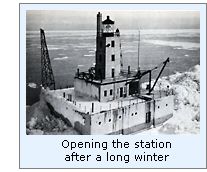 The caissons were then capped with seven-foot thick slab of steel
reinforced concrete. Forms were then installed around the outer edge of
this slab, and 30-inch thick concrete walls poured, creating a 69-foot
square basement within the crib. Sub forms within the exterior walls
created openings for doors six feet above the water level on the north
and south sides, and 27 24" diameter porthole-style windows. Atop
the walls, a 12-inch thick slab of steel reinforced concrete was poured,
with central support provided by steel columns bolted to the basement
floor. This second slab sat 20 feet above lake level, and served as both
the main deck of the structure and as the ceiling for the basement
below. This basement was divided into two sections on opposite sides of
the crib, with one side serving as a machinery room and the other as
sleeping quarters for the crew. The caissons were then capped with seven-foot thick slab of steel
reinforced concrete. Forms were then installed around the outer edge of
this slab, and 30-inch thick concrete walls poured, creating a 69-foot
square basement within the crib. Sub forms within the exterior walls
created openings for doors six feet above the water level on the north
and south sides, and 27 24" diameter porthole-style windows. Atop
the walls, a 12-inch thick slab of steel reinforced concrete was poured,
with central support provided by steel columns bolted to the basement
floor. This second slab sat 20 feet above lake level, and served as both
the main deck of the structure and as the ceiling for the basement
below. This basement was divided into two sections on opposite sides of
the crib, with one side serving as a machinery room and the other as
sleeping quarters for the crew.
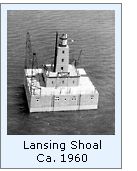 The machinery room housed a pair of diesel-powered electric
generators which were to supply power to the main light, radiobeacon and
general lighting throughout the structure. A small gasoline engine
powered generator served as a backup to the main generators in the case
of a failure with the main units. A pair of diesel-powered compressors
provided compressed air for the diaphone fog signal, two air-powered
derricks mounted on the northeast and northwest corners of the main
deck, and also provided pressure to the dwelling’s plumbing systems. A
coal storage bunker provided fuel for a hot water heating system,
connected to radiators throughout the dwelling. To both reduce noise and
fumes in the four bedrooms on the opposite side of the crib, the two
areas were separated by a ventilated hallway and the floor of the four
bedrooms stood sixteen inches above those in the equipment area. The machinery room housed a pair of diesel-powered electric
generators which were to supply power to the main light, radiobeacon and
general lighting throughout the structure. A small gasoline engine
powered generator served as a backup to the main generators in the case
of a failure with the main units. A pair of diesel-powered compressors
provided compressed air for the diaphone fog signal, two air-powered
derricks mounted on the northeast and northwest corners of the main
deck, and also provided pressure to the dwelling’s plumbing systems. A
coal storage bunker provided fuel for a hot water heating system,
connected to radiators throughout the dwelling. To both reduce noise and
fumes in the four bedrooms on the opposite side of the crib, the two
areas were separated by a ventilated hallway and the floor of the four
bedrooms stood sixteen inches above those in the equipment area.
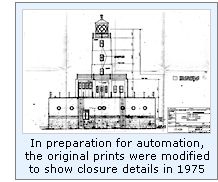 Centered on the main deck above the basement, structural steel
framework was erected and sheathed with reinforced concrete walls
standing 37 feet square, with walls 12’ 8" high. As was the case
with the basement below, this main structure served double duty, housing
a large boat storage room, kitchen, dining room and living rooms for the
crew. Constructed in a similar manner to the main structure, the tower
rose three stories above the center of the flat roof of the main
structure, and stood 13-feet square at the base, with three stepped
sections tapering to 11 feet square below the gallery. A room
immediately below the lantern housed a Type F diaphone, with its
resonator protruding through the wall for maximum sound dispersion. Atop
the tower, a circular cast iron lantern was installed with helical
astragals, and outfitted with an occulting white Third Order Fresnel
lens illuminated by a 500-watt incandescent electric lamp. With a focal
plane of 69 feet, the lens was visible for a distance of 16 miles in
clear weather. Centered on the main deck above the basement, structural steel
framework was erected and sheathed with reinforced concrete walls
standing 37 feet square, with walls 12’ 8" high. As was the case
with the basement below, this main structure served double duty, housing
a large boat storage room, kitchen, dining room and living rooms for the
crew. Constructed in a similar manner to the main structure, the tower
rose three stories above the center of the flat roof of the main
structure, and stood 13-feet square at the base, with three stepped
sections tapering to 11 feet square below the gallery. A room
immediately below the lantern housed a Type F diaphone, with its
resonator protruding through the wall for maximum sound dispersion. Atop
the tower, a circular cast iron lantern was installed with helical
astragals, and outfitted with an occulting white Third Order Fresnel
lens illuminated by a 500-watt incandescent electric lamp. With a focal
plane of 69 feet, the lens was visible for a distance of 16 miles in
clear weather.
While there was still interior finish work remaining, and the
radiobeacon had yet to be installed, the new light was exhibited for the
first time on the night of October 6, 1928, and lightship LV98 was
removed from her anchorage and reassigned to Twelfth District relief
duty.
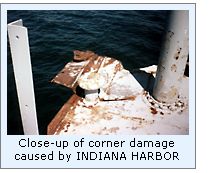 With completion of the interior trim work and the installation of the
200-watt radiobeacon the following spring, work at Lansing Shoal was
completed at a total cost of $262,000. The reinforced concrete
construction of the station made for an extremely strong structure,
which was put to the test during the great Armistice Day Storm of
November 11, 1940. With fierce northwestern gales blowing across the
lake, two freighters and a grain carrier were lost, and 70 storm-related
deaths recorded between Ludington and South Haven alone. During this
storm, winds of 126 miles per hour were recorded at Lansing Shoal, and
the station was coated with seven inches of ice, and most of the
porthole windows were blown out, causing the keepers to ride out the
storm in an inner room within the crib. With completion of the interior trim work and the installation of the
200-watt radiobeacon the following spring, work at Lansing Shoal was
completed at a total cost of $262,000. The reinforced concrete
construction of the station made for an extremely strong structure,
which was put to the test during the great Armistice Day Storm of
November 11, 1940. With fierce northwestern gales blowing across the
lake, two freighters and a grain carrier were lost, and 70 storm-related
deaths recorded between Ludington and South Haven alone. During this
storm, winds of 126 miles per hour were recorded at Lansing Shoal, and
the station was coated with seven inches of ice, and most of the
porthole windows were blown out, causing the keepers to ride out the
storm in an inner room within the crib.
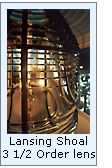 The Lansing Shoals Light was one of the last to be built on the Great
Lakes, and thus was one of the shortest lived. With advances in RADAR
and LORAN-C, through the sixties and seventies, such manned stations had
outlived their usefulness. The Coast Guard cutter Buckthorn arrived at
Lansing Shoal in the summer of 1976, and disassembled the Third Order
Fresnel, replacing the magnificent glass jewel with a diminutive
solar-powered 190 mm acrylic optic. After removing anything of value and
securing the station, the final crew was removed from the Light and
carried back to Station Charlevoix. At some point thereafter, all
windows in the station were sealed with brick and mortar, and the walls
sprayed with a coat of gunite , in order to reduce maintenance costs
and to help prevent vandalism. The Lansing Shoals Light was one of the last to be built on the Great
Lakes, and thus was one of the shortest lived. With advances in RADAR
and LORAN-C, through the sixties and seventies, such manned stations had
outlived their usefulness. The Coast Guard cutter Buckthorn arrived at
Lansing Shoal in the summer of 1976, and disassembled the Third Order
Fresnel, replacing the magnificent glass jewel with a diminutive
solar-powered 190 mm acrylic optic. After removing anything of value and
securing the station, the final crew was removed from the Light and
carried back to Station Charlevoix. At some point thereafter, all
windows in the station were sealed with brick and mortar, and the walls
sprayed with a coat of gunite , in order to reduce maintenance costs
and to help prevent vandalism.
In 1995, the 1,000-foot freighter INDIANA HARBOR passed too close to
the station, smashing into the crib, damaging some of the concrete of
the crib and smashing the metal corner protection on the station deck.
Amazingly, neither the light nor the vessel sustained major damage.
While no crews have tended the light in almost 30 years, Lansing
Shoal still beams her flashing white light fifteen miles across Lake
Michigan, warning mariners of the dangers lurking below the water. The
old Third Order Fresnel lens from the lighthouse was subsequently placed
on display at the Lansing State Museum, in Lansing.

Keepers of this Light

Click
Here
to see a complete listing of all Lansing Shoal Light
keepers compiled by Phyllis L. Tag of Great Lakes Lighthouse Research.

Seeing this Light

We have yet to visit this light. We plan to visit in 2004, and will
report on our observations at that time. Thanks to Bernie and
Everett for honoring us with their photographs.

Finding this Light

This is an offshore light, and we are not
currently aware of any tours or charter boats that offer services to the
light. Thus, you will require your own seaworthy vessel to make the
trip.

Reference Sources

Annual reports of the Lighthouse
Board, various, 1891 - 1909
Annual reports of the Lake Carriers Association, various, 1901 -
1911
Great Lakes Light Lists, various, 1901 - 1997
Lightships and Lightship Stations of the United States Government,
Willard Flint, 1989
Holland's extremes of the century, Jim Pruitt. Holland Sentinel,
01/01/00
Northern Lights, Charles K. Hyde,
1995.
email from Bernard Hellstrom concerning 1995 collision, 01/02/00
The Long Ships Passing, Walter Havighurst,
1943
Keeper listings for this light appear
courtesy of Great
Lakes Lighthouse Research
|
